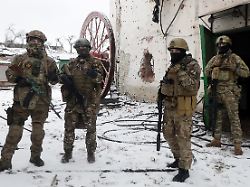Time is ticking for the Kremlin
London: New Russian tactics rely on attrition
By Alexander Schultze
02/24/2023 11:42 am
Even if the Russian military is not currently achieving any great successes, the British secret service believes that it could have more staying power in the fight. The Kremlin seems to have changed tactics accordingly: wearing down Ukrainian troops is initially more important than gaining land.
According to British intelligence, the Russian military could take a new approach to its tactics. The campaign may now focus more on weakening the Ukrainian military rather than making major gains in territory. The calculation behind it: In the end, Russia can always send new soldiers into the fight, position more tanks or artillery, even if they are not state-of-the-art. Ukraine may defend boldly and efficiently, but are outnumbered in every respect.
Time is running out for Russia. Even if the much-awaited major offensive is not really recognizable as such, it still causes numerous pinpricks to which the Ukrainian armed forces have to react, says military expert from the European Council of Foreign Relations (ECFR), Gustav Gressel, ntv.de. In his eyes, Russia’s attacks on a broad front – especially near Wuhledar, Bakhmut and Kreminna – do not indicate a real offensive. To do this, troops would actually be concentrated in one place and then, supported by artillery, attack massively. However, that is currently not the case with the Russian efforts. Instead, smaller groups tend to attack, which could be repelled more easily by the Ukrainian defenders.
It is different in the city of Bachmut. According to the ISW report, very well-trained and well-equipped Wagner mercenaries were first used there to conquer the city and neighboring Soledar. The towns have formed the front line between Ukrainian soldiers and pro-Russian fighters since 2014. The defensive positions of the Ukrainians are therefore very well developed and difficult to conquer. There are also many experienced and well-trained Ukrainian fighters in the region. The number of victims was correspondingly high among the Russian special forces.
However, the tactics that the British secret service now generally applies to the Russian military were apparently successful: high personnel costs, which admittedly only achieved small gains in territory, but above all weakened the Ukrainian defenders more and more through constant storming.
At Soledar new tactics of the Russians are working
Wagner boss Yevgeny Prigozhin recruited tens of thousands of fighters from among Russian prisoners and offered them freedom in return for combat use. Many followed his call. According to Western experts, the Wagner group was now about 50,000 strong. However, the new recruits were not as well trained as long-time mercenaries and not as well equipped. Their task was to run towards Ukrainian defense positions in constant waves, thus exposing them. Among them, the death toll was extremely high. 9,000 Wagner mercenaries are said to have fallen in the meantime, and around 20,000 more were wounded, according to US intelligence services. The Russian artillery was then able to fire on the Ukrainian positions.
The Ukrainians had to spend a lot of ammunition to keep the Russians from taking over their positions. An extreme battle of attrition ensued, in which Russia held out longer due to a larger number of fighters. In the end, the city of Soledar could be conquered in this way, in Bachmut Wagner mercenaries had previously penetrated the outskirts. However, the city is significantly larger than Soledar, and there is a risk of house-to-house fighting for both sides, which will result in losses.
According to military experts Gressel, the Russian military has little choice but to choose the current tactics. Russia lacks the reserve divisions, officers and military headquarters to mount a serious offensive. “In a normal reserve battalion, the people have known each other for ten years, have practiced together many times, are able to assess what they can and cannot do,” says Gressel.
In the mobilized Russian battalions, on the other hand, some people were assembled into units who had never met before and who had just been trained enough to have a chance of surviving in combat. “They don’t fight combined arms. That’s why Russia is currently opting for small-scale offensives. They’re easier to coordinate,” explains Gressel.
